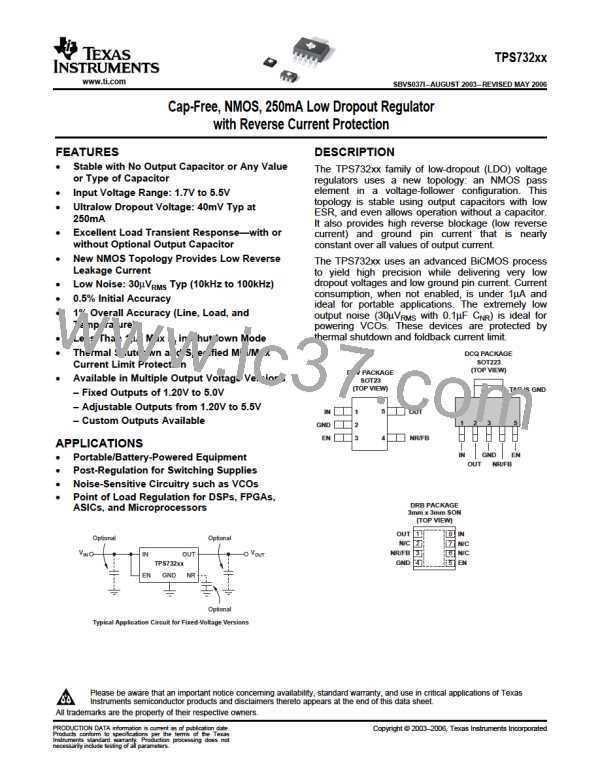TPS732xx
www.ti.com
SBVS037I–AUGUST 2003–REVISED MAY 2006
(Adjustable voltage version)
35°C above the maximum expected ambient
condition of your application. This produces
a
VOUT
dVńdt +
worst-case junction temperature of 125°C at the
highest expected ambient temperature and
worst-case load.
(
)
COUT 80kW ø R1 ) R2 ø RLOAD
(5)
REVERSE CURRENT
The internal protection circuitry of the TPS732xx has
been designed to protect against overload
conditions. It was not intended to replace proper
heatsinking. Continuously running the TPS732xx into
thermal shutdown will degrade device reliability.
The NMOS pass element of the TPS732xx provides
inherent protection against current flow from the
output of the regulator to the input when the gate of
the pass device is pulled low. To ensure that all
charge is removed from the gate of the pass
element, the enable pin must be driven low before
the input voltage is removed. If this is not done, the
pass element may be left on due to stored charge on
the gate.
POWER DISSIPATION
The ability to remove heat from the die is different for
each
package
type,
presenting
different
considerations in the PCB layout. The PCB area
around the device that is free of other components
moves the heat from the device to the ambient air.
Performance data for JEDEC low- and high-K boards
are shown in the Power Dissipation Ratings table.
Using heavier copper will increase the effectiveness
in removing heat from the device. The addition of
plated through-holes to heat-dissipating layers will
also improve the heat-sink effectiveness.
After the enable pin is driven low, no bias voltage is
needed on any pin for reverse current blocking. Note
that reverse current is specified as the current
flowing out of the IN pin due to voltage applied on
the OUT pin. There will be additional current flowing
into the OUT pin due to the 80kΩ internal resistor
divider to ground (see Figure 1 and Figure 2).
For the TPS73201, reverse current may flow when
VFB is more than 1.0V above VIN.
Power dissipation depends on input voltage and load
conditions. Power dissipation is equal to the product
of the output current times the voltage drop across
the output pass element (VIN to VOUT):
THERMAL PROTECTION
Thermal protection disables the output when the
junction temperature rises to approximately 160°C,
allowing the device to cool. When the junction
temperature cools to approximately 140°C, the
output circuitry is again enabled. Depending on
power dissipation, thermal resistance, and ambient
temperature, the thermal protection circuit may cycle
on and off. This limits the dissipation of the regulator,
protecting it from damage due to overheating.
PD + (VIN * VOUT) IOUT
(6)
Power dissipation can be minimized by using the
lowest possible input voltage necessary to assure
the required output voltage.
Package Mounting
Solder pad footprint recommendations for the
TPS732xx are presented in Application Bulletin
Solder Pad Recommendations for Surface-Mount
Devices (AB-132), available from the Texas
Instruments web site at www.ti.com.
Any tendency to activate the thermal protection
circuit indicates excessive power dissipation or an
inadequate heatsink. For reliable operation, junction
temperature should be limited to 125°C maximum.
To estimate the margin of safety in a complete
design (including heatsink), increase the ambient
temperature until the thermal protection is triggered;
use worst-case loads and signal conditions. For good
reliability, thermal protection should trigger at least
13
Submit Documentation Feedback

 TI [ TEXAS INSTRUMENTS ]
TI [ TEXAS INSTRUMENTS ]